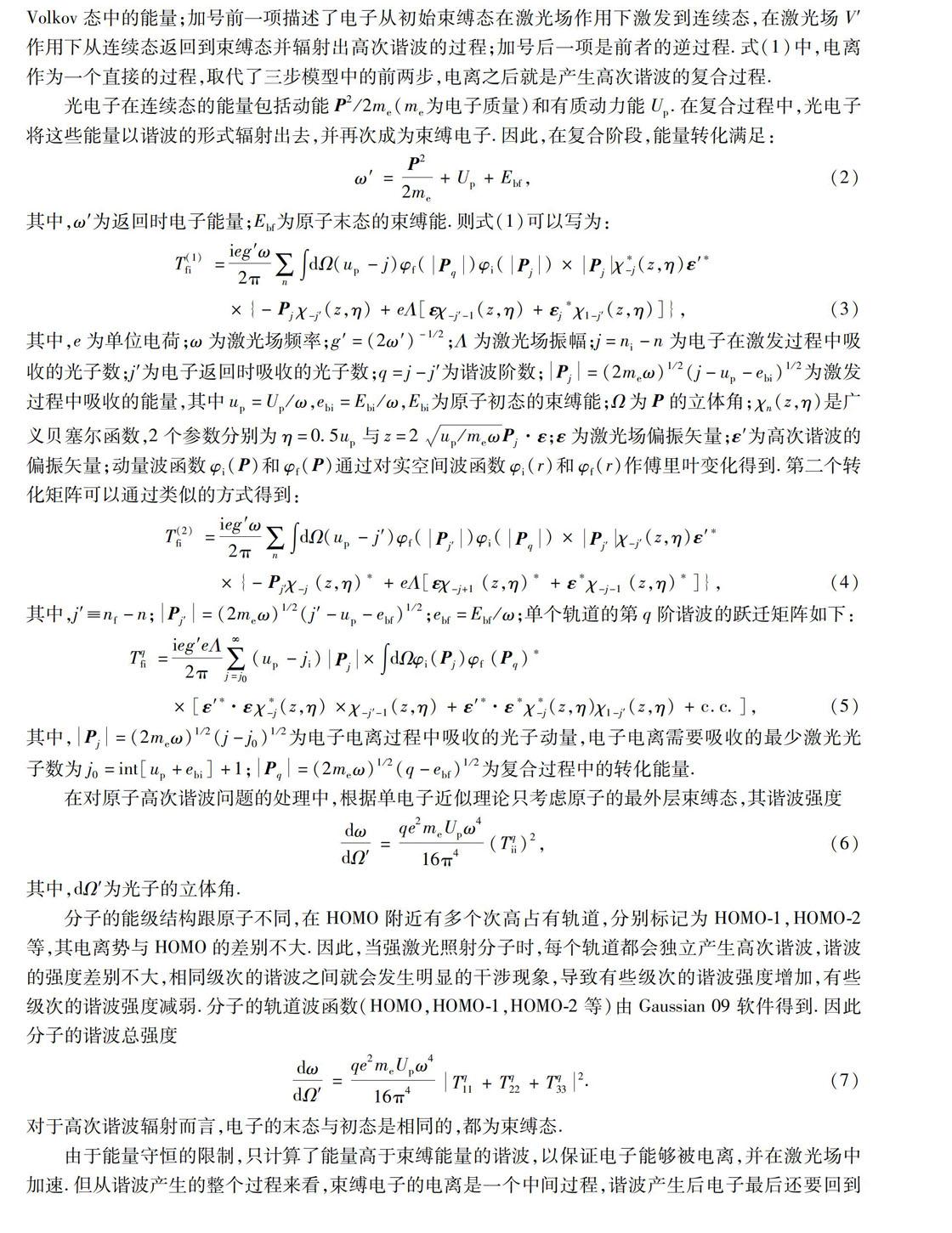氧分子低阈值谐波中的干涉效应
洪永沛 张敬涛



摘 要: 通过改进的非微扰量子电动力学(QED)理论,研究了强激光场中激发分子产生的高次谐波,并分析了能量低于电离阈值的谐波随激光波长的变化.研究结果表明:当激光光强较高时,氧分子产生的谐波极小值是多个分子轨道独立产生的谐波相互干涉的结果;随着入射光波长的改变,单个分子轨道辐射的谐波出现π相位的突变,导致总谐波谱中出现了极小值;当光强较低时,总谐波由最高占据分子轨道(HOMO)产生的谐波主导,总谐波极小值即为HOMO谐波极小值.另外,随着激光波长的改变,单个复合通道产生的谐波也会发生π相位的突变,与不同复合通道产生的谐波相干叠加后造成单个分子轨道谐波的极小值.
关键词: 低阈值谐波; 分子轨道谐波; 谐波干涉
中图分类号: O 437.1 文献标志码: A 文章编号: 10005137(2019)04039307
Abstract: In this paper,the nonperturbative quantum electrodynamics(QED) theory was developed to study the highorder harmonic generation from the molecules irradiated by the strong laser field.The relationship between the harmonics with energy below the ionization threshold and the laser wavelength was analyzed.It was found that the minimum of harmonics generation from oxygen molecules by high light intensity laser field is the result of interference of multiple molecular orbitals.As the wavelength of incident laser changed,the harmonic phases of single molecular orbital appeared to be πphase mutations,resulting in minimum among the total harmonic.When the light intensity was lower,the total harmonic was dominated by the harmonics generated by the highest occupied molecular orbit (HOMO).Therefore,the total harmonic minimum was the minimum of the HOMO harmonic.Besides,with the change of laser wavelength,the harmonic generated by a single return channel would also have a πphase mutation.The harmonics generated by different return channels were coherently summed up to produce an interference minimum of a single molecular orbital harmonic.
Key words: belowthreshold harmonic generation; harmonic of molecular orbital; harmonic interference
0 引 言
原子/分子在與强激光相互作用的过程中,可以产生频率为入射光频率整数倍的高次谐波.随着谐波能量的增加,高次谐波的强度首先快速下降,之后是一个平台期,最终在截止区快速下降.截止区能量为Ip+3.17Up,其中,Ip为原子/分子的电离势,Up为电子在激光场中的有质动力势.高次谐波具有较宽的频谱,相邻阶次谐波间的频率差为2ω.利用高次谐波可以获得阿秒级脉冲,用于探测在阿秒-埃尺度上的现象,如跟踪原子/分子中电子的跃迁等超快过程,为探究电子动力学过程提供了有效途径[1-6],ASEYEV等[7]精准测量了电子的阿秒动力学过程.采用中红外光场作为驱动场,可以大大提高截止区的能量,获得相干极紫外光[8-15].
高次谐波辐射的机制可以用CORKUM[16]提出的半经典三步模型理论解释.高次谐波的强度取决于电子与母核的复合几率,而后者又依赖于母核的基态波函数.高次谐波辐射本质是电子在基态与连续态之间跃迁,因此谐波携带了原子/分子的基态波函数信息,可以作为探究原子/分子/结构的一种手段[17],据此人们发展了分子轨道成像技术[18-22].
最近对高次谐波的研究热点集中在低阈值谐波.YOST等[23]探究了氙的低阈值谐波谱,发现低阈值谐波辐射主要由长量子轨道和多光子激发2个过程产生,并且前者较后者对低阈值谐波辐射的贡献更多.相较于原子,分子具有更为复杂的能级结构和电子云分布,不同分子轨道辐射的谐波对总谐波谱也会产生影响.SOIFER等[24]对分子的近阈值谐波进行了研究,发现分子近阈值谐波主要受长量子轨道和短量子轨道影响,其中长量子轨道产生的谐波可以用三步模型理论解释,并且与分子电离势相关;而短量子轨道则可以用来探究分子的激发态.XIONG等[25]观察了低阈值谐波强度随激光频率的变化,由谐波强度峰值位置推断谐波的产生机制,固定频率处出现的峰为电子跃迁到激发态的共振吸收峰,电子回到激发态并辐射的谐波为共振辐射.峰值随光强和频率的变化为量子轨道干涉现象,光强越高,电子返回能量越低,长量子轨道对低阶谐波的影响越大.上述低阈值谐波的研究仅限于原子,对分子也只研究了总谐波,并未涉及分子内部各个轨道产生的谐波,存在一定的局限性.
本文作者發展了非微扰量子电动力学(QED)理论,并用之来处理分子在强激光场中产生的高次谐波过程[26],重点研究了不同分子轨道低阈值单阶次谐波谱随入射激光波长的变化,探究了低阈值谐波出现极小值的原因.研究结果表明:随着入射激光波长的改变,低阈值谐波谱会产生一系列的极小值;总谐波强度极小值在激光强度较高时为分子不同轨道谐波相互干涉的结果;激光强度较低时,总谐波强度为最高占据分子轨道(HOMO)主导,极小值即为HOMO谐波强度极小值.另外,单个轨道的谐波谱也会出现极小值的情况,不同复合轨道间的干涉会使单个轨道产生谐波的极小值.
3 结 论
利用非微扰QED理论计算氧分子的高次谐波谱,加入零势能点修正与库仑势修正得到了低阈值谐波.研究结果表明:低阈值谐波强度随着入射光波长的变化会出现极小值,当激光强度较高时,随着入射激光波长的改变,分子单个轨道谐波相位发生幅度为π的突变,与其他轨道辐射的谐波干涉导致分子总谐波强度出现极小值;当激光强度较低时,总谐波强度由HOMO产生的谐波主导,谐波强度极小值即为HOMO谐波强度极小值.研究单个轨道辐射的谐波发现:随着入射光波长的改变,单个复合通道产生的谐波相位也会发生幅度为π的突变,与其他通道的谐波干涉导致谐波强度出现极小值.
参考文献:
[1] ZHAI C,ZHU X,LAN P,et al.Diffractive molecularorbital tomography [J].Physical Review A,2017,95(3):033420.
[2] LI Y,ZHU X,LAN P,et al.Molecular orbital tomography beyond the plane wave approximation [J].Physical Review A,2014,89(4):123-127.
[3] HE M,ZHOU Y,LI Y,et al.Revealing the target structure information encoded in strongfield photoelectron hologram [J].Optical & Quantum Electronics,2017,49(6):232.
[4] ZHU X,ZHANG Q,HONG W,et al.Laserpolarizationdependent photoelectron angular distributions from polar molecules [J].Optics Express,2011,19(24):198-209.
[5] XIE H,LI M,LU P,et al.Carrierenvelope phase dependent photoelectron energy spectra in low intensity regime [J].Optics Express,2017,25(10):11233.
[6] LIU X,LI P,ZHU X,et al.Probing the ππ*,transitions in conjugated compounds with an infrared femtosecond laser [J].Physical Review A,2017,95(3):033421.
[7] ASEYEV S A,NI Y,FRASINSKI L J,et al.Attosecond angleresolved photoelectron spectroscopy [J].Physical Review Letters,2003,91(22):223902.
[8] HENTSCHEL M,KIENBERGER R,SPIELMANN C,et al.Attosecond metrology [J].Nature,2001,414(6863):509-513.
[9] GOULIELMAKIS E,SCHULTZE M,HOFSTETTER M,et al.Singlecycle nonlinear optics [J].Science,2008,320(5883):1614-1617.
[10] LI J,REN X,YIN Y,et al.53attosecond Xray pulses reach the carbon Kedge [J].Nature Communications,2017,8(1):794.
[11] KFIR O,GRYCHTOL P,TURGUT E,et al.Generation of bright phasematched circularlypolarized extreme ultraviolet high harmonics [J].Nature Photonics,2014,9(2):99-105.
[12] FAN T,GYCHTOL P,KNUT R,et al.Bright circularly polarized soft xray high harmonics for xray magnetic circular dichroism [J].Proceedings of the National Academy of Sciences of the United States of America,2015,112(46):14206-14211.
[13] ZHANG X,ZHU X,LIU X,et al.Ellipticitytunable attosecond XUV pulse generation with a rotating bichromatic circularly polarized laser field [J].Optics Letters,2017,42(6):1027.
[14] LI L,WANG Z,LI F,et al.Efficient generation of highly elliptically polarized attosecond pulses [J].Optical & Quantum Electronics,2017,49(2):73.
[15] YUAN H,LI F,LONG H.Control of highorder harmonic generation with chirped inhomogeneous fields [J].Journal of the Optical Society of America B:Optical Physics,2017,34(11):2390.
[16] CORKUM P B.Plasma perspective on strong field multiphoton ionization [J].Physical Review Letters,1993,71(13):1994-1997.
[17] ITATANI J,LEVESQUE J,ZEIDLER D,et al.Tomographic imaging of molecular orbitals [J].Nature,2005,432(7019):867-871.
[18] LEIN M.Molecular imaging using recolliding electrons [J].Journal of Physics B:Atomic Molecular & Optical Physics,2007,40(16):R135.
[19] HAESSLER S,CAILLAT J,SALIRES P.Selfprobing of molecules with high harmonic generation [J].Journal of Physics B:Atomic Molecular & Optical Physics,2011,44(20):203001.
[20] SALIRES P,MAQUET A,HAESSLER S,et al.Imaging orbitals with attosecond and ngstrm resolutions:toward attochemistry? [J].Reports on Progress in Physics Physical Society,2012,75(6):062401.
[21] HAESSLER S,CAILLAT J,BOUTU W,et al.Attosecond imaging of molecular electronic wavepackets [J].Nature Physics,2010,6(3):200-206.
[22] VOZZI C,NEGRO M,CALEGARI F,et al.Generalized molecular orbital tomography [J].Nature Physics,2011,7(10):823-827.
[23] YOST D C,SCHIBLI T R,YE J,et al.Vacuumultraviolet frequency combs from belowthreshold harmonics [J].Nature Physics,2009,5(11):815-820.
[24] SOIFER H,BOTHERON P,SHAFIR D,et al.Nearthreshold highorder harmonic spectroscopy with aligned molecules [J].Physical Review Letters,2010,105(14):143904.
[25] XIONG W H,GENG J W,TANG J Y,et al.Mechanisms of belowthreshold harmonic generation in atoms [J].Physical Review Letters,2014,112(23):233001.
[26] GUO D S,BERG T,CRASEMANN B.Scattering theory of multiphoton ionization in strong fields [J].Physical Review A,1989,40(9):4997-5005.
[27] AMMOSOV M V,DELONE N B,KRAINOV V P.Tunnel ionization of complex atoms and atomic ions in electromagnetic field [J].Proceedings of SPIEThe International Society for Optical Engineering,1986,64:1181.
[28] ZHANG J,WU Y,ZENG Z,et al.Intensitydependent multiorbital effect in highorder harmonics generated from aligned O2 molecules [J].Physical Review A,2013,88(3):3156-3161.
(責任编辑:顾浩然)

